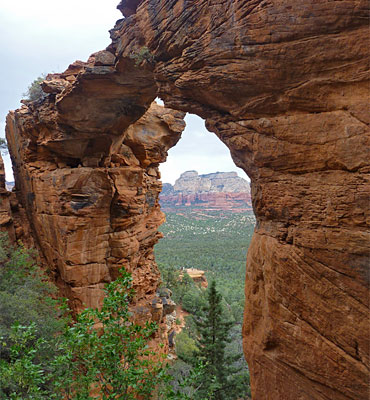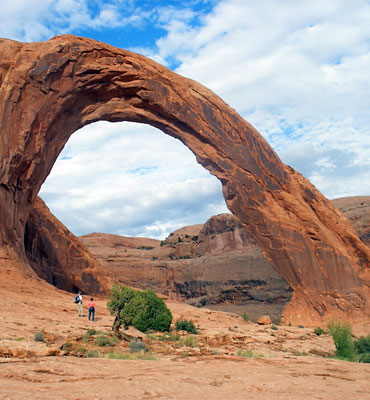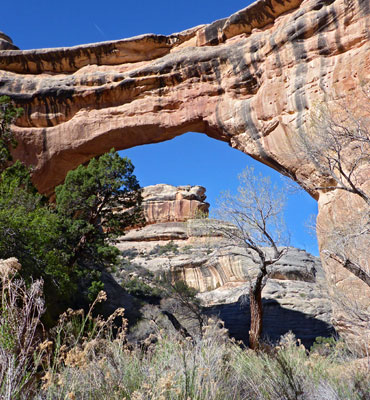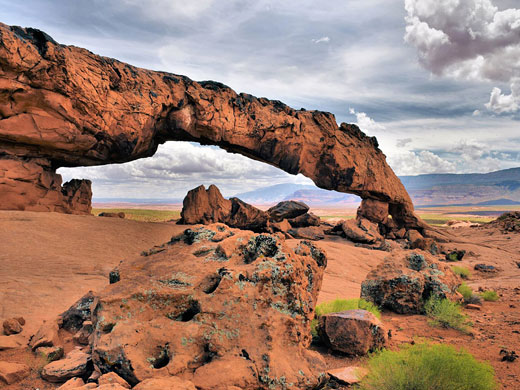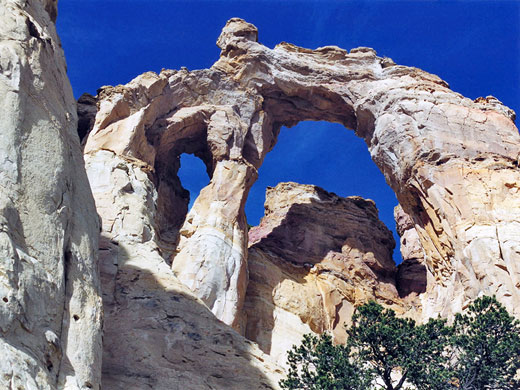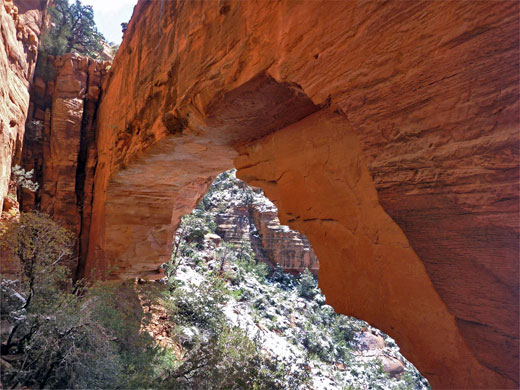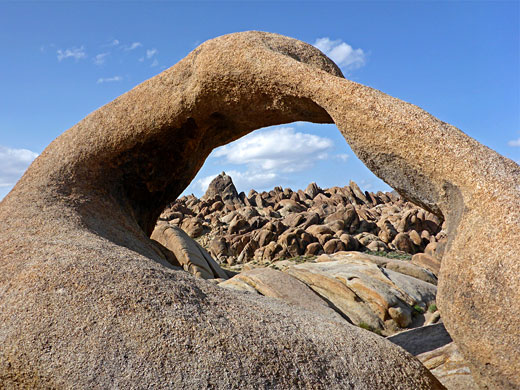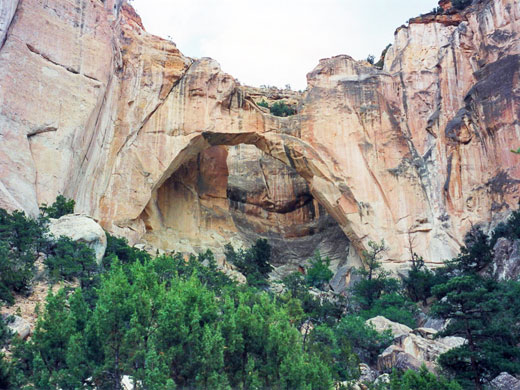A natural bridge is an opening in a rock or cliff face which has been created by the action of flowing water and hence is a less common feature than an arch, as these are made by a variety of erosive factors including natural weathering, rockfalls, frost and ocean waves.
Sea arches are numerous along the Pacific coastline, especially north California and south Oregon (locations such as Damnation Creek, Point Lobos, Samuel H Boardman Scenic Corridor and Trinidad), and both types of opening may be seen in scattered locations all across the Southwest, but by far the majority occur in the sedimentary rocks of the Colorado Plateau, most notably in south Utah.
Away from here, a few miscellaneous sites include Natural Bridge Canyon (Death Valley, CA), Natural Bridge (Yellowstone, WY) and Tonto Natural Bridge (AZ).
Table of Contents
Sea arches are numerous along the Pacific coastline, especially north California and south Oregon (locations such as Damnation Creek, Point Lobos, Samuel H Boardman Scenic Corridor and Trinidad), and both types of opening may be seen in scattered locations all across the Southwest, but by far the majority occur in the sedimentary rocks of the Colorado Plateau, most notably in south Utah.
Away from here, a few miscellaneous sites include Natural Bridge Canyon (Death Valley, CA), Natural Bridge (Yellowstone, WY) and Tonto Natural Bridge (AZ).
Table of Contents
Most Colorado Plateau arches are in Utah - nearly 200 are named on topographic maps but many more are undesignated, and the prime location is Arches National Park near Moab, which has over 1,000 - ranging from small, nameless cavities 3 feet across to 290 foot Landscape Arch, and over 20 larger examples may be seen either beside the scenic drive or along short trails. The most well-known of all, Delicate Arch, is reached by a slightly longer hike of 1.5 miles.
On the west side of Moab, the 15 mile Potash Road follows the Colorado River close to several arches including Corona, Bowtie, Pinto and Jug Handle, while further west, the vast expanse of Canyonlands National Park contains dozens more large spans, the majority far from any road, such as:
Likewise, Capitol Reef National Park and Grand Staircase-Escalante National Monument have huge areas of backcountry wilderness with many more arches, plus numerous other photogenic erosive features. In the former, some notable arches are:
On the west side of Moab, the 15 mile Potash Road follows the Colorado River close to several arches including Corona, Bowtie, Pinto and Jug Handle, while further west, the vast expanse of Canyonlands National Park contains dozens more large spans, the majority far from any road, such as:
- Angel, Crescent, Fisheye, Kirk and Wedding Ring arches, the Needles - along upper Salt Creek
- Castle, Fortress, Gothic and Paul Bunyans Potty arches, the Needles - along Horse Canyon
- Cleft Arch, the Needles - in upper Lavender Canyon
- Druid Arch, the Needles - 5.4 miles south of Squaw Flat Campground
- Gemini Bridges, in Bull Canyon, just north of the park
- Horsehoof Arch, the Needles - southwest of Chesler Park
- Mesa Arch - most popular in the park, a short walk from the Island in the Sky road
- Musselman Arch, in Musselman Canyon, below the White Rim
- Washer Woman Arch, visible from the Mesa Arch Trail
- Brimhall Natural Bridge, near Halls Overlook close to the south edge of the park
- Cassidy Arch, above Grand Gulch, close to the scenic drive
- Hickman Bridge, reached by a 1.2 mile trail
- Muley Arch, Peek-a-Boo Arch, Saddle Arch and Trinity Arch, in Muley Twist Canyon
- Sheets Gulch Arch
- Bement Arch, in Davis Gulch, near the south end of the Hole-in-the-Rock Road
- Bowington Arch, in an Escalante River side canyon, downstream of UT 12
- Broken Bow Arch, in Willow Gulch, a tributary of Fortymile Gulch
- Cedar Wash Arch and Covered Wagon Natural Bridge, along a side track west of the Hole-in-the-Rock Road
- Cliff Arch, Coyote Natural Bridge and Jacob Hamblin Arch - in lower Coyote Gulch
- Escalante Natural Bridge, beside the Escalante River, a short walk from UT 12
- Grosvenor Arch, along Cottonwood Canyon Road
- Mamie Creek Natural Bridge, in a tributary of Death Hollow - reached by the Boulder Mail Trail
- Maverick Natural Bridge and Phipps Arch, reached by a 4 mile hike from UT 12
- Sunset Arch, an Entrada sandstone formation, accessed from Forty Mile Ridge Road
Arches are also quite common in the San Rafael Swell and Glen Canyon NRA. Further west, Kodachrome Basin State Park includes Shakespeare Arch (though this has collapsed), while nearby Bryce Canyon National Park has several arch-like formations such as Tower Bridge, Natural Bridge and multiple openings along the Wall of Windows.
Many visitors to Zion National Park drive past the Great Arch, though this is merely a large span in front of a cliff, without an actual opening. The biggest true arch in the park, one of the largest in the state, is in the north-west area (Kolob Canyons); this is Kolob Arch, which needs a 7 mile hike to reach.
The largest natural bridge in Utah is Rainbow Bridge, part of a national monument which is just within range of a long, strenuous day hike across remote lands of the Navajo reservation, but virtually all visitors arrive by boat, either privately owned or on commercial tours, since the bridge spans a side canyon near the edge of Lake Powell, 35 miles from Page. The other major location is Natural Bridges National Monument, along UT 95 between Hite and Blanding. This preserve has three large bridges, named Sipapu, Kachina and Owachomo, plus Anasazi ruins, petroglyphs and fine canyon scenery.
There are many red rock arches around Moab, outside of the two national parks, such as Funnel Arch and Morning Glory Arch.
The largest natural bridge in Utah is Rainbow Bridge, part of a national monument which is just within range of a long, strenuous day hike across remote lands of the Navajo reservation, but virtually all visitors arrive by boat, either privately owned or on commercial tours, since the bridge spans a side canyon near the edge of Lake Powell, 35 miles from Page. The other major location is Natural Bridges National Monument, along UT 95 between Hite and Blanding. This preserve has three large bridges, named Sipapu, Kachina and Owachomo, plus Anasazi ruins, petroglyphs and fine canyon scenery.
There are many red rock arches around Moab, outside of the two national parks, such as Funnel Arch and Morning Glory Arch.
There are few Colorado Plateau arches in Arizona, but the state does contain the largest outside Utah - remote Wrather Arch, along the Paria River. On the south edge of the plateau, Sedona is one of the main places for eroded red rocks, and has three arches reached by trails, namely:
The largest arch in New Mexico is La Ventana Natural Arch, along the east side of El Malpais National Monument; this volcanic preserve also has several lava bridges, in the Big Tubes area. Other arches in the state include Arch Rock and Cox Canyon Arch (both near Aztec), Red Lake Natural Bridge near Navajo by the Arizona stateline, and Zuni Arch, also near El Malpais NM.
Only a small part of the Colorado Plateau extends into the state of Colorado, but one area close to the Utah stateline, southwest of Grand Junction, has the second greatest concentration of large arches anywhere. These are found in Rattlesnake Canyon, in a rather remote and difficult-to-reach area on the south side of the Colorado River.
Perhaps the most well known location for arches in California is the Alabama Hills, near Lone Pine below the steep east face of the Sierra Nevada. Wave-cut arches can be found at several locations along the southern Pacific coast, such as Montaña de Oro State Park near Morro Bay.
- Devils Bridge - at the end of a 0.8 mile trail starting from Dry Creek Road
- Fay Canyon Arch, a little way along a popular trail into a short red rock ravine
- Vultee Arch, in wooded surroundings west of Sterling Pass
The largest arch in New Mexico is La Ventana Natural Arch, along the east side of El Malpais National Monument; this volcanic preserve also has several lava bridges, in the Big Tubes area. Other arches in the state include Arch Rock and Cox Canyon Arch (both near Aztec), Red Lake Natural Bridge near Navajo by the Arizona stateline, and Zuni Arch, also near El Malpais NM.
Only a small part of the Colorado Plateau extends into the state of Colorado, but one area close to the Utah stateline, southwest of Grand Junction, has the second greatest concentration of large arches anywhere. These are found in Rattlesnake Canyon, in a rather remote and difficult-to-reach area on the south side of the Colorado River.
Perhaps the most well known location for arches in California is the Alabama Hills, near Lone Pine below the steep east face of the Sierra Nevada. Wave-cut arches can be found at several locations along the southern Pacific coast, such as Montaña de Oro State Park near Morro Bay.
All Contents © Copyright The American Southwest | Comments and Questions | Contribute | Affiliate Marketing Disclosure | Site Map
